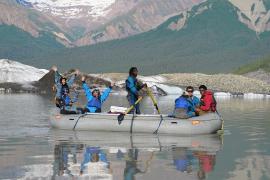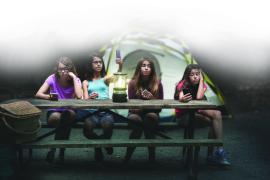When I was seventeen, I was hired for the second summer at my beloved home camp by the veteran camp director. She had become my mentor and friend through all my years as a camper, teen leader, and young staff member. I adored her, and I was fiercely loyal — as were all of my counselor friends. We were pumped up to “own” the camp once again and all indications were that it would be another stellar summer.
Then, without warning, the letter came. It was from a woman I had never met. “I’m excited to be your new camp director this summer.” Say what? Red alert! The whole staff was buzzing with the news, and we all had the same worries. This camp was our home — our turf — and we “knew everything there was to know” (of course). But now we had our first “intruder.” I can’t say that my posse and I rolled out the red carpet for this new camp director. We arrived hesitantly to staff training and left our carefree smiles at home. No one knew what to expect. It was time to find out how bad this was really going to be. We entered the dining hall looking for our seat, which was designated with our individualized staff manual. (Our seats are assigned? What’s up with THIS?) As I opened the cover, I could hear everyone’s silent thoughts swirling around in my own head: “Hey, not only does this look different, it IS different! What’s up with flag-raising not being before breakfast anymore? We ALL have to stay in our unit on the first night now? You’ve got to be kidding me!”
Truth be told, they were good changes, but that’s easy for me to see now as a camp director myself. I still remember the nervousness I felt when our new director walked in the door back then. Eight years later, I was anxious and excited to start my new venture as a camp director at a sixty-year-old camp I had never attended. Thinking about how I wanted my first day with my staff to unfold, I uncovered some uncomfortable truths. These people don’t know me yet. They don’t know that I’ve sat in their chairs before, and they don’t know the experiences I am drawing from. I have a lot of respect to earn here, and I have to go about earning it in a calculated way.
This understanding led me to my very first decision: Not every change needs to be made right now.
Eight Steps to Success
I’m sure new camp directors (and veteran directors with an eye on change) walk into the job with a mantra of “I’m going to make this camp the BEST it can be!” But before taking a red pen to the camp’s procedures or trashing the staff manual, directors should stop and consider these eight steps for making changes to camp life.
1. If it’s not broken, don’t fix it.
At least for your first season, I recommend this one simple golden rule. When is something “broken?” In my opinion, it’s only broken if it’s unsafe, unsound (has potential to become unsafe), or unfair.
Buddy check procedures that take over four minutes to get an accurate count? Broken. Events that haze or humiliate campers? Broken. Activities that have built a thick file of incident reports in your new office? Broken.
If it IS broken, it’s an easy decision. In fact, it’s not really a decision at all. It’s your absolute right and duty, as the person responsible for this camp, to fix it — no matter how your staff feels about it. One would hope that there aren’t too many things in this category that you need to handle during your first year.
Beyond that, this is the year that you start racking up credibility points to make the changes you feel will enhance the camp experience in the future. Fight the urge to change too many things right now because — if you truly are a vision¬ary camp director — there are probably many things that you feel could be enhanced. But before long, if you start changing a bunch of procedures and events all at once, your staff will get the impression that you are changing “everything,” and then your respect goose is cooked. So this year, just put the money in the bank. Be out of the office, visible, and engaged. Don’t watch things; participate with the understanding that you are going to LEARN what this camp is about. Then in year two, year three, etc., try following these guidelines to achieve the very best camp you are looking to run.
2. Get the buy-in of key leadership staff.
Meet with them before staff training even starts. Take them to lunch. Find out what the “sacred cows” are and in what direction they would like to see camp move. Then, on the first day of training, staff will already be walking in with a confidence about you and will surely relay that confidence to the rest of the staff.
3. Get on their train before you try to get them on yours.
If your presence has not been witnessed during “the old way,” you will have no credibility to change it. This is why you don’t change things that aren’t “broken” in the first year. Let your staff see you experiencing the issue for awhile, gain credibility, and go in for the change later.
4. Explain how this change does not impact cherished traditions.
If it’s true, and you can be up front about it in explaining the change, the uneasy feeling in your staff will subside while you feed them the details. “I know this is different, but I’m excited that the campers will get even more out of this and we can still keep the tradition alive.”
5. If it’s going to make their jobs easier, point it out.
Some changes that will increase the value of the campers’ experience may actually require more work on the part of your staff. Mature staff members will understand this when the time comes to make the change. But if a change will actually make the counselors’ jobs less stressful, why not get their endorsement?
6. The rationale behind your decision is never “because this is how we did it at my other camp.”
“Hi, I’m a red flag. Nice to meet you.” If you really want to be thrown to the wolves, go ahead and try that one. But if you are implementing a change that mirrors a procedure from somewhere you’ve already been, it’s probably because it WORKS. Try relaying that message to your staff instead. Tell them factually what you think should change and how it will be easier or better. They don’t need to know where the idea came from.
7. Offer the “Try It Before You Buy It” plan.
Staff are much more likely to try something new if they know up front that they are not sentenced to something that may not work. It’s important to let your staff know that this is something that, as a team, you are going to try to see if it works better. After a couple of weeks, you will ask for their feedback to assess if it’s really working. If it is, great! If not, you may try something else.
8. Make the change.
Here’s a real example. For two summers, I watched our lunch times in the picnic pavilion. As a counselor, I would have hated it. One hundred kids were crammed onto barely enough picnic tables, counselors had no place to sit at all, kids were getting bored waiting for all groups to arrive before they could even touch their lunch (and consequently started misbehaving), older kids got bored singing all of the “little kid” songs, and every camper found an excuse to get up from the table several times. It was chaotic.
But was it broken? According to the criteria, no. It was safe. Lunch was eaten by all campers. The schedule was followed. Most importantly, it was a tradition for the whole camp to eat together. I just felt strongly that lunch could be managed in a much less stressful (and much more fun) way. So I actually didn’t touch this one until summer number three.
At that point, I approached the staff during training and said, “You know, the assistant director and I have been talking, and I’ve been watching the way we do lunch for two summers now. My feeling is that it’s kind of a stressful time for you. I see campers giving you a lot of behavior problems, they don’t like to sit down, you’re doing everything you can to encourage them to participate in songs, and you guys don’t even have a place to sit! If you ask me, you’re not getting the fun and rewarding lunch time that you deserve.”
Wow, was that “getting on their train” or what? They knew I’d experienced countless lunch times right next to them. There’s my credibility. Now I’m outlining my concerns as if they’re about the counselors being able to do their jobs easier, but ultimately, I’m most concerned about the campers’ experience. I’m essentially recruiting the staff to want to make this change for me. But it was going to be a biggie.
“What if we divided lunch into two periods?” Of course, there was a little bit of expected bucking at that. But I quickly offered the “Try It Before You Buy It” plan, and I knew I had them on board for at least two weeks.
The result? We split into two lunch periods by age. Each group had two picnic tables to spread out at, the coun-selor had a place to sit with their group, and wouldn’t you know — campers didn’t want to get up all the time because they had enough personal space! The songs were tailored to the age level; virtually everyone participated without prompting. We tweaked the schedule a bit based on staff feedback, and at that point, the staff was totally bought-in. Now, each lunch period has even started developing their own micro-traditions, and the younger kids talk about when the day comes that they get to be part of the “big kid” lunch. Do you think that has had a positive effect on our retention of older campers? You bet.
Now That You’ve Made the Changes, Get Rid of the Bad Apples
After experiencing some changes and feeling confident that traditions have not been broken, mature staff members will board your train permanently. That doesn’t mean that they will like all of the changes you’ve made, but they will understand your ultimate responsibility and your rationale. One of the toughest staffing decisions I made was not re-hiring a counselor who had virtually grown up through the camp. I could tell we were not on board together about the direction that camp was heading, and his personal dislike for me was made clear through his behavior, gossip, and overall job performance. When the staff convened for staff training that next summer, I came to find out that while he had been a much-liked person, he was not well-liked as a co-worker. They felt he hadn’t pulled his weight and had a horrible attitude (even before I arrived on the scene) and were glad to be moving forward without this “bad apple.” Here I had anticipated the need to publicly explain my decision in order to start off with positive morale, but removing that staff member boosted morale long before training ever began. It sure pays to make tough decisions.
Can I Bypass the Guidelines?
Perhaps you arrive on the scene and your leadership staff tells you about a change they’ve been hoping to make for some time. The whole staff has been asking for it for years. Who knows, maybe the last camp director was actually the obstacle blocking a positive change. If you already have staff members buying in, and you have reasonable confidence that this change will be a positive one, try it — but reserve the right to change it back if it turns out that the new way is “broken.” If it works, you just earned a load of credibility points because the staff will feel that you’re really listening.
The Result
Going into my fifth summer as camp director, I can say there has been a lot of change at my camp, but in small doses. Feedback on camper and parent surveys indicate an increased level of satisfaction with the overall camp experience. And you know what? We’ve basically kept all of the sacred cows — we just manage them better. Some staff members from the previous management are still around, and now they are my right-hand people. But perhaps my most rewarding report is that I am still good friends with the camp director who “intruded” my home camp twelve years ago, and she has been monumental in her guidance to me when I ask her, “How did you ever deal with me?”
Running a quality camp is as much about making tough decisions as it is about knowing WHEN to make them. If you can prioritize changes over time, you’ll have a much smoother transition with a staff that will actually help you create positive change in the long run, and your campers’ experiences will be much better for it.
Heidi Krueger is the camp director at YMCA Camp Wabansi near Green Bay, Wisconsin, and coordinator of year-round family programs at YMCA Camp U-Nah-Li-Ya. She can be reached at [email protected].
Originally published in the 2011 July/August Camping Magazine.



